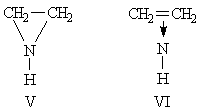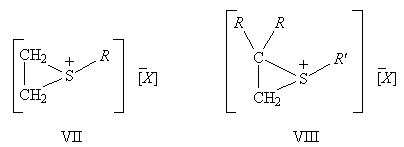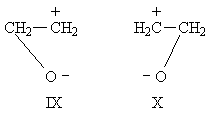C.A. McDowell, Nature 1947, 159, 508
copyright © 1947 Macmillan Magazines Ltd.
Structures of Ethylene Oxide and Cyclopropane
IT has recently been suggeested by Walsh1 that the structures I and II represent the properties of ethylene oxide and cyclopropane better than do the classical formulæ III and IV. In these new structures the oxygen atom in I, and the CH2 group in II, are attached to the double bond by a dative link formed from the π-electron pair of the 'ethylene' portion of the molecule. These ideas were apparently put forward because Zimakov2 has lately pointed out that the classical Würtz formula for ethylene oxide does not adequately account for its high reactivity; also because formula IV gives no indication of the characteristic reactivity of cyclopropane.

The conception of π-electron dative bonds is due originally to Dewar3, and though it does help to explain certain molecular rearrangements, its use in the suggested structures makes it difficult to reconcile these with the known Raman and infra-red spectra of ethylene oxide and cyclopropane. If the double bond in structures I and II has the properties usually associated with such a linkage, then both these compounds should show a strong Raman band (polarized) in the region of 1,600 cm.-1 due to the >C=C< vibration: in ethylene4 this band occurs at 1,623 cm.-1.
Both structures I and III belong to the point group C2v; the irreducible representations for vibrations of this point group are 5A1 + 3A2 + 4B1 + 3B2, of which all are allowed as fundamentals in the Raman spectrum, while the A2 vibrations are forbidden in the infra-red spectrum. The A1 vibrations in the Raman spectrum are polarized, hence if structure I were correct we should also got a band in the infra-red spectrum in the region of 1,600 cm.-1. The Raman and infra-red spectra of ethylene oxide5, and of the related ethylene sulphide6, are well known; but there are no Raman bands near 1,600 cm.-1 in the spectra of either of these compounds; and the observed spectra are in conformity with the requirements of the symmetry group C2v.
Cyclopropane as represented by structure IV belongs to the point group D3h, which has as irreducible representations 3A1' + 1A1" + 1A2' + 2A2" + 4E' + 3E", of which the A1", A2", and A2' vibrations are forbidden in the Raman spectrum and only the E' and A2" vibrations allowed in the infra-red spectrum. The A1' vibrations in the Raman spectrum are polarized. The Raman and infra-red spectra of this compound have been examined by a number of workers5, and the experimental results confirm these deductions. Again, no Raman line is found near 1,600 cm.-1.

Further, and perhaps more conclusive evidence, could be obtained if the Raman and infra-red spectra of ethyleneimine V were examined; for if this compound has a π-electron dative bond as in VI, then the frequency of the N-H vibration should be different from the value usually found for this linkage when the nitrogen is part of a heterocyclic system.
From the purely chemical point of view, there is also evidence against a π-electron dative bond in these substances, for Deléphine7 has found that ethylene sulphide forms crystalline sulphonium compounds of the type VII.

In this connexion it is interesting to note that the sulphonium ions of compounds of the type VIII are asymmetric and should exhibit optical isomerism, since they are analogous to those organic sulphur compounds which have been successfully resolved8. In fact, if compounds like VIII were resolvable, it would be strong evidence against the occurrence of a π-electron dative bond in ethylene sulphide.
Thus, though structures I and II are suggestive, it is difficult to accept them as representing ethylene oxide and cyclopropane. In the case of the former there seems no reason, at the moment, to go beyond Zimakov's suggestion that it be regarded as a resonance hybrid in which structures IX and X predominate.

This would account adequately for the reactivity of this substance and yet be consistent with the known Raman and infra-red spectra. The reactivity of cyclopropane could also be ascribed to resonance between analogous structures.
C. A. MCDOWELL
Dept. of Physical and Inorganic Chemistry,
University of Liverpool.
Feb. 25.
- Walsh, Nature, 159, 165 (1946).
- Zimakov, Acta Phys. Chim. U.S.S.R., 31, 401 (1946).
- Dewar, J. Chem. Soc., 406, 777 (1946).
- Herzberg, "Infra-red and Raman Spectra", 326 (van Nostrand. 1945). Full references to original work are given here.
- Lespieau and Grédy, C.R. Acad. Sci. Paris, 196, 399 (1933). Timms and Mecke, Z. Phys., 97, 221 (1935). Ananthakrishnan, Proc. Ind. Acad. Sci., 4A, 82 (1936). Kohlrausch and Reitz, Proc. Ind. Acad. Sci., 8A, 255 (1938). Bonner, J. Chem. Phys., 5, 704 (1937). Linnett, J. Chem. Phys., 6, 692 (1938).
- Thompson and Dupré, Trans. Farad. Soc., 36, 805 (1940).
- Deléphine, C.R. Acad. Sci. Paris, 171, 36 (1920).
- Pope and Peachey, J. Chem. Soc., 77, 1072 (1900). Smiles, J. Chem. Soc., 1174 (1900). Balfe, Kenyon and Phillips, J. Chem. Soc., 2554 (1930).